Fairey Swordfish, Off Achill Island, Mayo. June 1944
On the early morning of Monday, 19th June, 1944, an aircraft was observed by the Look Out Post (LOP) Moyteoge Head, Achill island, ½ mile south circling and later crashed into the sea at 07:32 hrs. The Coastwatcher on duty, Volunteer Cafferky called to his district commander in Castlebar to report on the events. He was instructed by the District Officer to make arrangements to go to the assistance of the people who were seen to have abandoned the aircraft. That district officer, Lt. Thomas P Lyons penned a report on the 23rd of June to the Officer Commanding the Armies G2 (Intelligence) branch based at Custume Barracks in Athlone. This was in turn copied forward to the G2 Head Quarters in Dublin and read:
Sir,
I have the honour to submit the following report concerning
the above.
At 07:40 on 19/6/44 I received a telephone message from Achill
Head L.O.P. to say that an aircraft had been seen to descend
into the sea 1 ½ miles south of the L.O.P. at 07:32 hrs. that
morning.
I instructed Volunteer Cafferky, who was on duty at the time
to inform Cpl. O’Malley (N.C.O. i/c of the L.O.P.) who was
then on his way to the LOP to change the Watch, of the
occurrence and to instruct him to procure a boat immediately
and to proceed towards the scene.
Cpl. O’Malley obtained a boat from Michael McHugh, Dooagh, at
Keem Bay, where McHugh and his crew were engaged in Salmon
fishing. McHugh and Volunteer Cafferky accompanied him in the
boat to the scene.
The crew left the pane and took to rubber Dingies. They
drifted with the outgoing tide with the result that the
rescuers had to row some three miles before they picked them
up safely. By this time the airmen were very wet and the pilot
was seasick. O’Malley and his assistants succeeded with some
difficulty in bringing the three Airmen and the rubber dingies
ashore at about 10:35 hrs at Keem Bay. The Sergt. i/c Keek
Garda Barracks and Rev. Fr. Langan, C.C. Dooagh were waiting
on the shore and Fr. Langan drove the three survivors to
Achill Head Hotel in his car.
I arrived at Dooagh at 10:40 hrs. and met the airmen on their
journey to the Hotel. I interviewed the pilot and obtained
from him the names of the crew which were as follows.
Sub. Lieut. Rooke (Pilot)
Sub. Lieut Kearey
Leading Aircraftman McRae
Fr. Langan, representing the Local Red Cross Branch, obtained
clothing and boots for all three. I ordered Refreshments,
meals, cigarettes, etc. for them and handed the bills to
Captain Birthistle that evening when he arrived to take over
the crew.
I enclose a bill for £5 (five pounds) received from McHugh and
consider the amount reasonable in view of the facts stated.
I have the honour to be
Your obedient servant
Thomas P Lyons Lieut.
DISTRICT OFFICER NO.12 DISTRICT
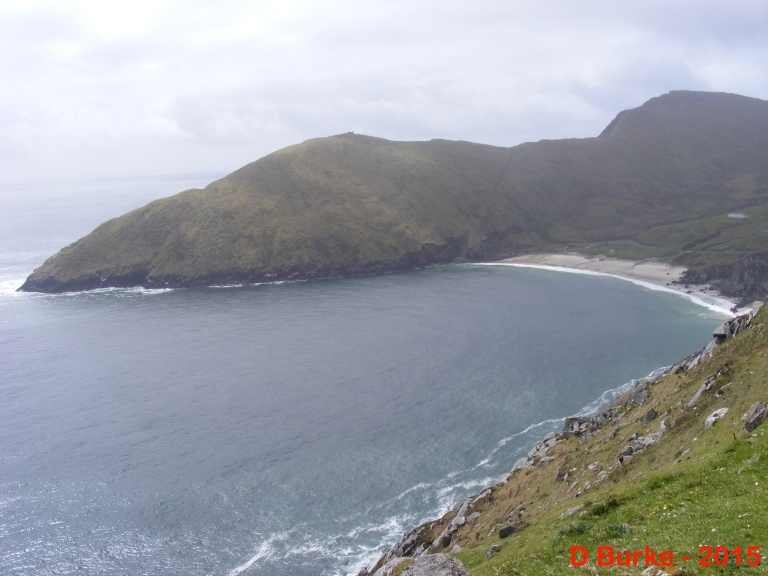
Upon being landed at Keem Bay, Achill, shown in the photograph above, the crew were saturated from being in the water and thus the local parish priest Rev. J J Langan arranged that they be supplied with boots from the local Red Cross organisation. They were further supplied with clothing from visitors to Achill Hotel. In the aftermath of the crews rescue, they were driven from Achill to the Border with Northern Ireland where they were handed over to UK forces at 01:30 hours on the morning of June 20th. Having left Keel after 20:00 hours on the previous evening. Captain J K Birthistle of the Army’s G2 branch was particularly excised at this because others had told the British party to be at the border at 21:00 hours the previous evening.
At the border, it was agreed that the boots and clothing would be returned by post to the Achill Hotel and returned to the owners.
There is an undated hand written note in the Army file that
“Major Delamore states he believes machine was a
“Barracuda”(Fleet Air arm Torpedo Bomber, Twin engine, crew
3.”). The aircraft was actually a Fairey Swordfish, a pre war
torpedo bomber which by this late stage in the war, had been
relegated to the role of escort duties flying from the Royal
Navies fleet of Escort Carriers. More can be read about the
Swordfish on the website of the Navy
Wings website, the Royal Navy Historic Flight (RNHF) and
the Fly Navy Heritage Trust (FNHT). There is of course a Wikipedia
page about the aircraft. The British aviation publication,
Flight published the general arrangement drawings shown below
during 1943.
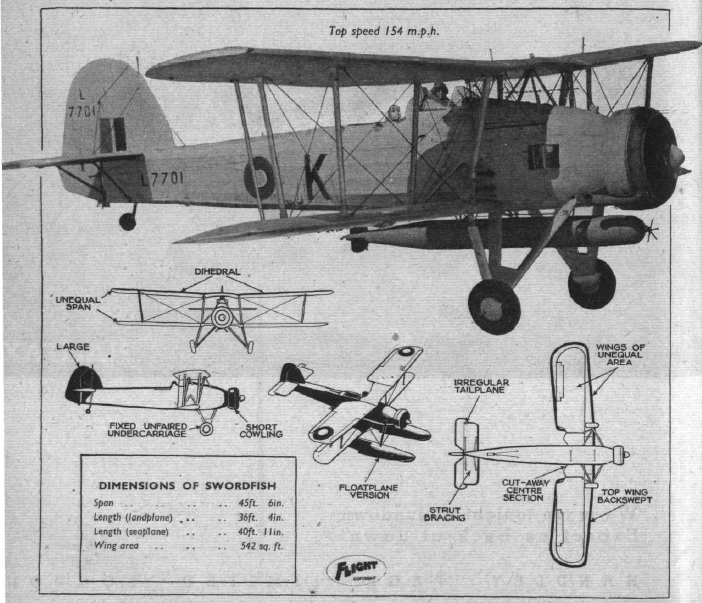
The approximate location of the ditching in indicated on the map below. This indicates an area centered on 2 miles south of Moyteoge Head. On this same day, three Liberator bombers crashed in Donegal killing 18 men, the worst single day for foreign air casualties in Ireland during the war.
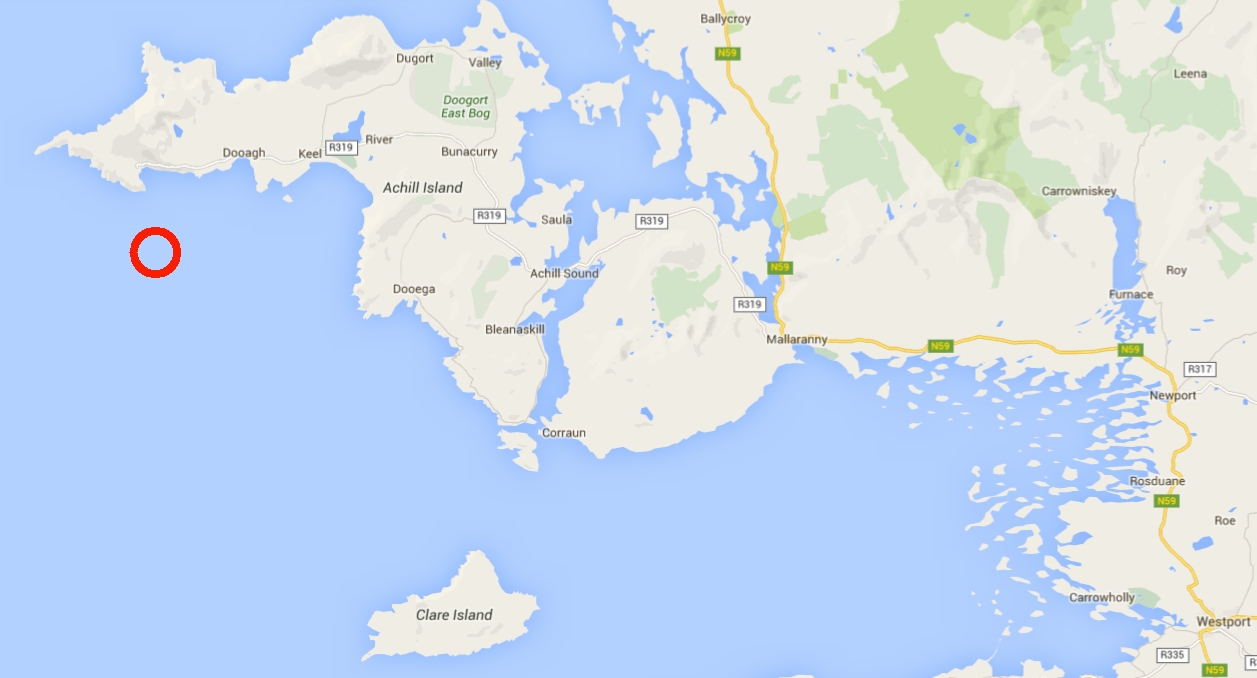
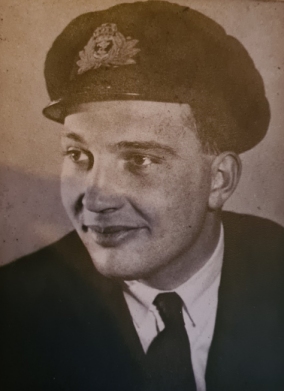 Jack Rooke was born to Annie and John
Rooke in Pontefrack in June 1921. The 1939 register lists
him living with his parents and working as a clerk. He was
commissioned as a Sub Lieutenant (Air) on 30th June 1943. In the
Navy List of February 1944 his is listed as serving with 813
Squadron having been posted there in November 1943. He was
married during the second quarter of 1944, not to distant from
the time of his ditching in the seat. In January 1945, there is
no posting listed by his name. In October 1945 he was still
listed as posted with 813 Squadron but his name is also listed
with HMS Nightjar, the Royal Naval Air Station at Inskip in
Lancashire. This was the location of Fleet Air Arm training
operations. His grand daughter understands that he was injured
while serving at sea in a non aviation related accident.
Jack Rooke was born to Annie and John
Rooke in Pontefrack in June 1921. The 1939 register lists
him living with his parents and working as a clerk. He was
commissioned as a Sub Lieutenant (Air) on 30th June 1943. In the
Navy List of February 1944 his is listed as serving with 813
Squadron having been posted there in November 1943. He was
married during the second quarter of 1944, not to distant from
the time of his ditching in the seat. In January 1945, there is
no posting listed by his name. In October 1945 he was still
listed as posted with 813 Squadron but his name is also listed
with HMS Nightjar, the Royal Naval Air Station at Inskip in
Lancashire. This was the location of Fleet Air Arm training
operations. His grand daughter understands that he was injured
while serving at sea in a non aviation related accident.
The book ‘Fleet Air Arm Aircraft 1939-1945’ lists three other
incidents that S/Lt Jack Rooke experienced during 1944 while
flying the Swordfish with 813 Squadron.
Swordfish NE869: 2nd March 1944, Engine Failure and
ditching in sea. Aircraft had already been forced landed after
losing a cylinder in Dec. 1943.
Swordfish NE893: The aircraft experienced a Heavy
Aerodrome Dummy Deck Landing in gusty wind, causing the tail
oleo to break on 20 April 1944.
Swordfish NE922: Starboard undercarriage collapsed
landing with two depth charges in the deck of HMS Campania only
on 14th June 1944.
Swordfish NE931 Delivered 23 November 1943. To 813
Squadron on HMS Campania on 4 February 1944. Official FAA record
says “Ditched when observer considered he was lost.”
He is pichured below standing on the wing of a Swordfish
bomber.
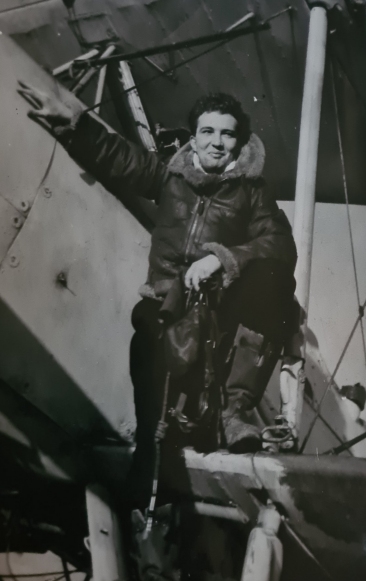
Jack Rooke passed away in 1985.
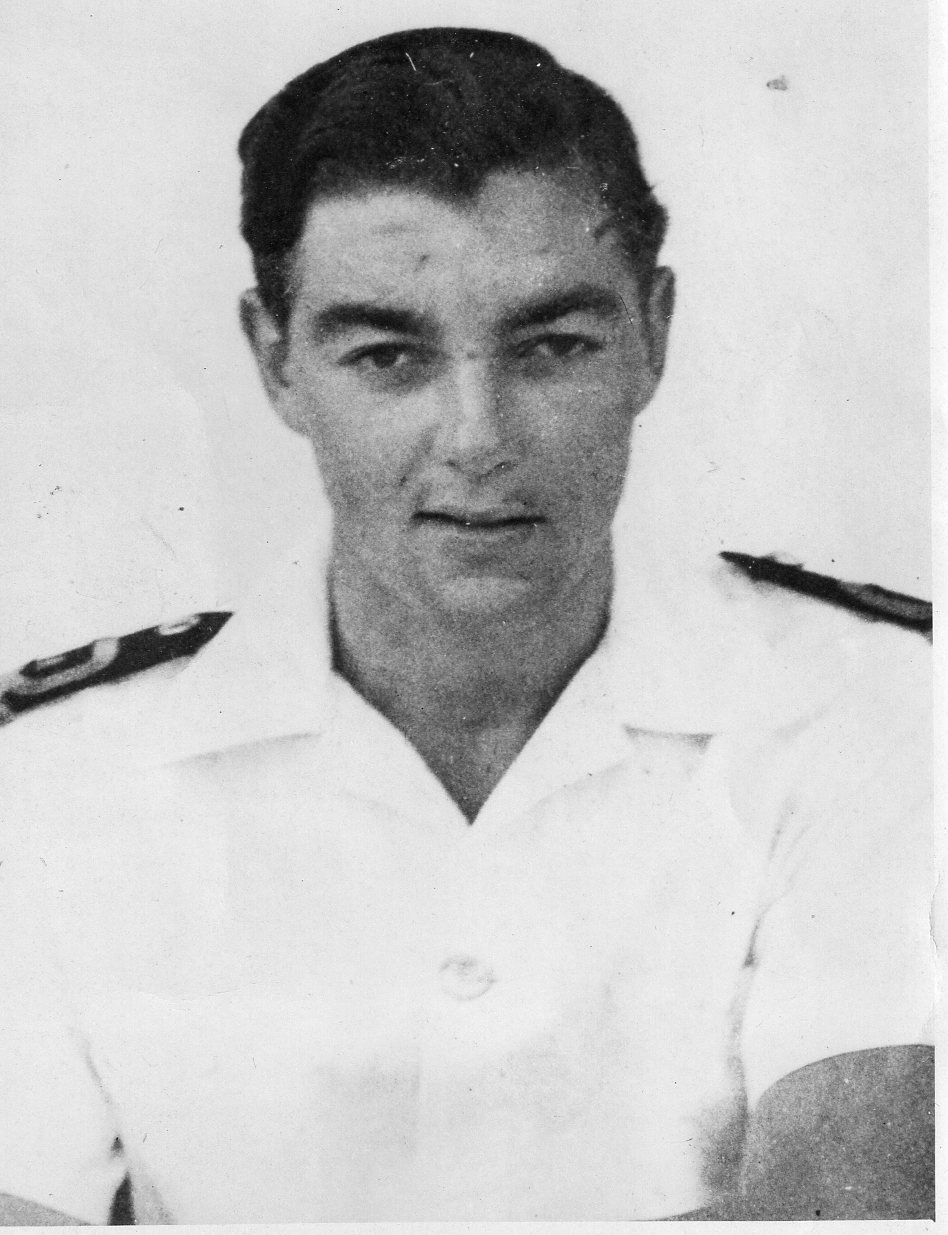 John Charles Kearey, son of
Mabelle Y Lauer and Charles H Kearey, was born in London in
1922. His father died when he was only seven years old. He was
commissioned as a Sub Lieutenant (Air) on 15 Nov 1943. His trade
was that of Observer, or Navigator. Shipping records show his
arrival in New York from Port of Spain, Trinidad and Tobago, in
the Caribbean on the 18th September 1943. It is assumed that he
was after completing his training on the island; perhaps at HMS
Goshawk, the Naval air station at Pairco. He was also posted to
813 Squadron on 1st November 1943. He remained with the Squadron
at least until October 1945 like S/Lt Rooke. The photo at
left dates from around 1944/1945.
John Charles Kearey, son of
Mabelle Y Lauer and Charles H Kearey, was born in London in
1922. His father died when he was only seven years old. He was
commissioned as a Sub Lieutenant (Air) on 15 Nov 1943. His trade
was that of Observer, or Navigator. Shipping records show his
arrival in New York from Port of Spain, Trinidad and Tobago, in
the Caribbean on the 18th September 1943. It is assumed that he
was after completing his training on the island; perhaps at HMS
Goshawk, the Naval air station at Pairco. He was also posted to
813 Squadron on 1st November 1943. He remained with the Squadron
at least until October 1945 like S/Lt Rooke. The photo at
left dates from around 1944/1945.
His family understand that he returned to Achill Island in the
1960's to seek out the men who rescued him to thank them.
In 2009, his daughter and her family visited Achill and met the
son of Thomas O'Malley and were treated to a tour of the Look
Out Post and Keem beach.
John Kearey passed away in the summer of 2001 in Cornwall.
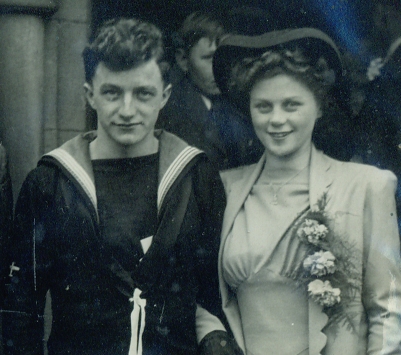 The third man
from the ditched Swordfish was the Telegraphist/Air Gunner,
referred to as the TAG in the Fleet Air Arm. He manned the rear
defence gun and operated the aircraft radio. His name was
recorded as Leading Airman McCrae only by the Irish Army
officers but an address for next of kin at 60 Hill Road, York
was able to connect this man to his identity. Among Fleet Air
Arm prisoners of war and war dead is listed the name of a TAG, W
J S McRae. Checking on the Commonwealth War Grave Commission
confirmed that he died during the war and that his widow lived
in York. A review of the UK National Probate Calendar for 1947
sadly confirmed that William James Smith McRae was
formerly resident at 60 Hill Road, York.
The third man
from the ditched Swordfish was the Telegraphist/Air Gunner,
referred to as the TAG in the Fleet Air Arm. He manned the rear
defence gun and operated the aircraft radio. His name was
recorded as Leading Airman McCrae only by the Irish Army
officers but an address for next of kin at 60 Hill Road, York
was able to connect this man to his identity. Among Fleet Air
Arm prisoners of war and war dead is listed the name of a TAG, W
J S McRae. Checking on the Commonwealth War Grave Commission
confirmed that he died during the war and that his widow lived
in York. A review of the UK National Probate Calendar for 1947
sadly confirmed that William James Smith McRae was
formerly resident at 60 Hill Road, York.
The Scottish National War Memorial records William McRae as being born in the town of Echt in Aberdeenshire in 1924. In early 1944 he married Joyce Mavis Reed in York. He was flying with 813 Squadron at the time of the ditching off Achill but at a later date he transferred to 849 Squadron which was flying the much more powerful and modern Grumman Avenger torpedo bomber. He was flying with this unit from the HMS Victorious on January 29th, 1945 as part of the British Pacific fleet’s attack on the Japanese oil refineries at Palembang, on the island of Sumatra in what is modern day Indonesia. His aircraft, Avenger JZ386, was seen to be hit and along with one other Avenger and crew, crash landed near Palembang. All of the men, including Williams’ crew mates Lt K M Burrenston and S/Lt W E J Lintern, survived the crashes and attempted to evade the Japanese forces but were eventually captured on or around the 12th of February. There after records become scarce and in the end, British investigators were only able to conclude that William McRae might have been shipped to Singapore with nine other Fleet Air Arm men, the “Palembang Nine”, and they may have been murdered there by Japanese personnel on or around the 31st July 1945. His remains were never found and thus his name is recorded on the Lee on Solent memorial to Royal Navy personnel by the Commonwealth War Graves Commission.
A memorial stone commemorating PO McRae and his nine comrades from the Palembang air strike is located in St. Bartholomews Church, Yeovilton. This memorial stone links the story back to PO McRae’s widow Mavis. Mavis like many wartime widows married again after the war but as late as 1988, she arranged to travel to Singapore to visit the memorial in Kranji to lay flowers for her late husband. They had met in 1943 while she worked as WREN at RNAS Inskip. They were married and spent just a short time together before he shipped out to the Far East never to return. Mavis started a campaign to have the Palembang Nine remembered by memorials and this resulted in the stone mentioned above and another in the Chiangi Prison Museum in Singapore. The story of her efforts is recorded on the Latham and Burscough Military Heritage website and in VANGUARD THE OFFICIAL JOURNAL OF THE ROYAL NAVAL ASSOCIATION NO.10 AREA APRIL 2008. Research elsewhere, including by the Royal New Zealand Navy however points out that the nature of the records that survived means that the ‘Palembang Nine’ might just form something of a legend and that the actual fate of the men including William McRae can never truly be known. He might have died in Sumatra or Singapore. Nevertheless the efforts of Mavis and others results in memorials for at least nine young airmen who, among hundreds of Allied prisoners in Japanese hands, were killed by the brutality of their captors.
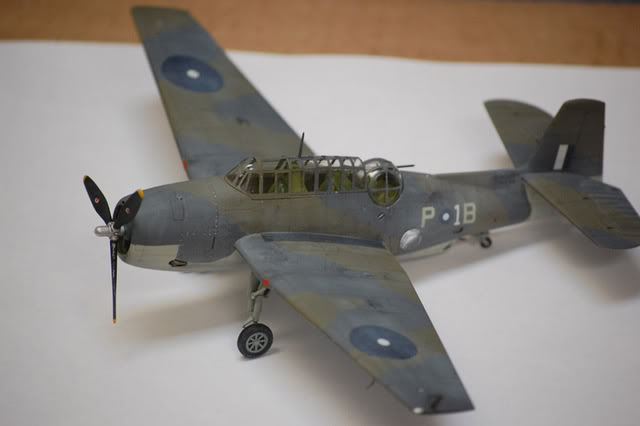 The husband of William's
niece created his own memorial to the young aviator by building
this model of the Avenger in which he flew on the day he was
shot down. More photos can be seen on the "72nd
Scale Aircraft' modeling forum.
The husband of William's
niece created his own memorial to the young aviator by building
this model of the Avenger in which he flew on the day he was
shot down. More photos can be seen on the "72nd
Scale Aircraft' modeling forum.
The history of Swordfish NE931 above links it to its assignment to 813 Squadron and in turn to the carrier Campania. HMS Campania was only in service less than four months in June 1944 and was on her first operational deployment. During June 1944 she was deployed to provide air cover for transit of outward Convoys OS79 and MKS53 to Gibraltar, inward Convoys SL160 and MKS51 to Liverpool from Gibraltar. It was while with the latter between 10th and 21st June that the ditching took place off Achill.
Compiled by Dennis Burke, 2022, Dublin and Sligo. With thanks to the Rooke, Kearey and McRae extended families.
